Energy Consumption and Energy-Related CO2 Emissions from China’s Petrochemical Industry Based on an Environmental Input-Output Life Cycle Assessment
Abstract
:1. Introduction
2. Literature Review
2.1. Review on the Development of Petrochemical Industry in China
2.2. Review on Methods
3. Methodology and Data
3.1. Estimation of Indirect Energy Consumption from Final Demand, Assessment of the Influence and Induction Coefficients of Energy Consumption
3.2. Estimation of Indirect CO2 Emissions, Assessment of the Influence and Induction Coefficients of CO2 Emissions
4. Results and Discussions
5. Conclusions
Author Contributions
Conflicts of Interest
Appendix A
| Sectors | Energy Consumption | CO2 Emissions | ||||||
|---|---|---|---|---|---|---|---|---|
| Influence Coefficient | Rank | Induction Coefficient | Rank | Influence Coefficient | Rank | Induction Coefficient | Rank | |
| Agriculture, Forestry, Animal Husbandry, Fishery | 0.40 | 39 | 0.51 | 21 | 0.36 | 39 | 0.27 | 11 |
| Mining and Washing of Coal | 1.27 | 10 | 3.00 | 4 | 0.91 | 23 | 1.09 | 7 |
| EPNG | 0.80 | 30 | 1.57 | 9 | 0.74 | 27 | 0.69 | 8 |
| Mining and Processing of Ferrous Metal Ores | 0.90 | 25 | 0.66 | 15 | 1.11 | 9 | 0.24 | 14 |
| Mining and Processing of Non-Ferrous Metal Ores | 0.96 | 21 | 0.59 | 18 | 1.00 | 14 | 0.09 | 24 |
| Mining and Processing of Nonmetal Ores | 0.91 | 23 | 0.42 | 22 | 0.97 | 18 | 0.19 | 17 |
| Support Activities and Mining of Other Ores | 1.31 | 8 | 0.89 | 11 | 1.00 | 15 | 0.27 | 12 |
| Processing and manufacture of Food, liquor, beverages, tea and tobacco | 0.48 | 38 | 0.35 | 24 | 0.42 | 38 | 0.16 | 19 |
| Manufacture of Textile | 0.89 | 26 | 0.87 | 12 | 0.68 | 33 | 0.22 | 16 |
| Manufacture of Textile, Apparel and Accessories | 0.73 | 34 | 0.08 | 38 | 0.57 | 36 | 0.02 | 35 |
| Manufacture of Leather, Fur, Feather, Footwear | 0.63 | 37 | 0.09 | 37 | 0.53 | 37 | 0.02 | 36 |
| Processing and manufacture of Timber, Wood, Bamboo, Rattan, Palm, and Straw Products | 0.79 | 31 | 0.34 | 25 | 0.74 | 28 | 0.11 | 22 |
| Manufacture of Furniture | 0.73 | 33 | 0.04 | 41 | 0.71 | 30 | 0.01 | 42 |
| Manufacture of Paper and Paper Products | 1.15 | 14 | 1.00 | 10 | 0.95 | 21 | 0.42 | 10 |
| Printing and Reproduction of Recording Media | 0.83 | 29 | 0.10 | 36 | 0.69 | 32 | 0.02 | 38 |
| Manufacture of Articles for Culture, Education, Arts and Crafts, Sport and Entertainment | 0.84 | 28 | 0.04 | 42 | 0.75 | 26 | 0.02 | 40 |
| PCNF | 1.23 | 11 | 2.48 | 6 | 0.99 | 17 | 1.38 | 6 |
| RCCP | 1.70 | 3 | 6.24 | 1 | 1.52 | 4 | 3.58 | 3 |
| Manufacture of Medicines | 0.66 | 36 | 0.23 | 28 | 0.60 | 35 | 0.11 | 23 |
| CF | 1.48 | 5 | 0.61 | 17 | 1.24 | 6 | 0.19 | 18 |
| RPP | 1.21 | 13 | 0.56 | 19 | 1.03 | 12 | 0.12 | 21 |
| Manufacture of Non-metallic Mineral Products | 1.82 | 2 | 2.26 | 8 | 1.78 | 3 | 1.74 | 5 |
| Smelting and Pressing of Ferrous Metals | 2.14 | 1 | 5.66 | 2 | 2.46 | 2 | 6.24 | 2 |
| Smelting and Pressing of Non-ferrous Metals | 1.37 | 7 | 2.34 | 7 | 1.14 | 7 | 0.47 | 9 |
| Manufacture of Metal Products | 1.30 | 9 | 0.40 | 23 | 1.41 | 5 | 0.08 | 25 |
| Manufacture of General Purpose Machinery | 1.01 | 18 | 0.30 | 26 | 1.02 | 13 | 0.12 | 20 |
| Manufacture of Special Purpose Machinery | 0.97 | 20 | 0.14 | 31 | 1.00 | 16 | 0.04 | 28 |
| Manufacture of Automobiles | 0.87 | 27 | 0.14 | 32 | 0.83 | 24 | 0.03 | 32 |
| Manufacture of Transport Equipment | 0.95 | 22 | 0.12 | 33 | 0.92 | 22 | 0.04 | 31 |
| Manufacture of Electrical Machinery, Apparatus | 1.03 | 17 | 0.17 | 30 | 0.95 | 20 | 0.03 | 34 |
| Manufacture of Computers, other electronic equip | 0.72 | 35 | 0.19 | 29 | 0.64 | 34 | 0.01 | 41 |
| Manufacture of Measuring Instruments | 0.79 | 32 | 0.11 | 34 | 0.73 | 29 | 0.02 | 39 |
| Other Manufacture | 1.55 | 4 | 0.80 | 13 | 0.80 | 25 | 0.04 | 30 |
| Utilization of Waste Resources | 0.24 | 42 | 0.07 | 39 | 0.25 | 42 | 0.04 | 29 |
| Repair Service of Metal Products and Equipment | 0.98 | 19 | 0.10 | 35 | 1.06 | 11 | 0.05 | 27 |
| Production and Supply of Electric and Heat Power | 1.38 | 6 | 3.54 | 3 | 5.01 | 1 | 21.10 | 1 |
| Production and Supply of Gas | 0.90 | 24 | 0.29 | 27 | 0.70 | 31 | 0.03 | 33 |
| Production and Supply of Water | 1.22 | 12 | 0.77 | 14 | 1.09 | 10 | 0.02 | 37 |
| Construction | 1.08 | 16 | 0.07 | 40 | 1.12 | 8 | 0.05 | 26 |
| Transport, Storage and Post | 1.11 | 15 | 2.66 | 5 | 0.97 | 19 | 2.12 | 4 |
| Wholesale, Retail Trade and Hotel, Restaurants | 0.31 | 41 | 0.55 | 20 | 0.26 | 41 | 0.23 | 15 |
| Others | 0.37 | 40 | 0.66 | 16 | 0.32 | 40 | 0.26 | 13 |
References
- National Bureau of Statistics. China National Economy and Social Development Statistical Bulletin 2015; China Statistical Press: Beijing, China, 2016.
- National Bureau of Statistics. China Statistical Yearbook 2007–2015; China Statistical Press: Beijing, China, 2015.
- Xie, X.; Shao, S.; Lin, B. Exploring the driving forces and mitigation pathways of CO2 emissions in China’s petroleum refining and coking industry: 1995–2031. Appl. Energy 2016, 184, 1004–1015. [Google Scholar] [CrossRef]
- State Council. The Thirteenth Five-Year Work Plan for Greenhouse Gas Emissions Control. Available online: http://www.gov.cn/zhengce/content/2016-11/04/content_5128619.htm (accessed on 29 September 2017).
- National Bureau of Statistics. National Economic Industry Classification Standard 2011; China Statistical Press: Beijing, China, 2011.
- Wu, X.; Zhang, Z. Input–output analysis of the Chinese construction sector. Constr. Manag. Econ. 2005, 23, 905–912. [Google Scholar] [CrossRef]
- Ministry of Industry and Information Technology. The Twelfth Five-Year Plan for the Development of Petrochemical and Chemical Industries. Available online: http://www.miit.gov.cn/n1146290/n1146397/c4241600/content.html (accessed on 29 September 2017).
- Ministry of Industry and Information Technology. The Plan for the Development of Petrochemical and Chemical Industries (2016–2020). Available online: http://www.miit.gov.cn/n1146295/n1652858/n1652930/n3757017/c5285161/content.html (accessed on 29 September 2017).
- Leontief, W. Environmental repercussions and the economic structure: An input-output approach. Rev. Econ. Stat. 1970, 262–271. [Google Scholar] [CrossRef]
- Xu, T.; Baosheng, Z.; Lianyong, F.; Masri, M.; Honarvar, A. Economic impacts and challenges of China’s petroleum industry: An input-output analysis. Energy 2011, 36, 2905–2911. [Google Scholar] [CrossRef]
- Hendrickson, C.; Horvath, A.; Joshi, S.; Lave, L. Economic input-output models for environmental life-cycle assessment. Environ. Sci. Technol. 1998, 32, 184–190. [Google Scholar] [CrossRef]
- Shui, B.; Harriss, R.C. The role of CO2 embodiment in US–China trade. Energy Policy 2006, 34, 4063–4068. [Google Scholar] [CrossRef]
- Zhang, Y.; Bian, X.; Tan, W.; Song, J. The indirect energy consumption and CO2 emission caused by household consumption in China: An analysis based on the input–output method. J. Clean. Prod. 2015, 163, 69–83. [Google Scholar] [CrossRef]
- Li, X.; Fan, T. Analysis of carbon emissions from China’s petrochemical industries using the LMDI method. In Proceedings of the International Conference on E-Product E-Service and E-Entertainment, Henan, China, 7–9 November 2010; pp. 1–4. [Google Scholar]
- Fan, T.; Luo, R.; Xia, H.; Li, X. Using LMDI method to analyze the influencing factors of carbon emissions in China’s petrochemical industries. Nat. Hazards 2015, 75, 319–332. [Google Scholar] [CrossRef]
- Intergovernmental Panel on Climate Change. IPCC Guidelines for National Greenhouse Gas Inventories; Institute for Global Environmental Strategies: Hayama, Japan, 2006; Volume 2, pp. 48–56.
- Liu, Z.; Guan, D.; Wei, W.; Davis, S.J.; Ciais, P.; Bai, J.; Peng, S.; Zhang, Q.; Hubacek, K.; Marland, G.; et al. Reduced carbon emission estimates from fossil fuel combustion and cement production in China. Nature 2015, 524, 335–338. [Google Scholar] [CrossRef] [PubMed]
- Wang, Z.; Liu, W.; Yin, J. Driving forces of indirect carbon emissions from household consumption in China: An input–output decomposition analysis. Nat. Hazards 2015, 75, 257–272. [Google Scholar] [CrossRef]
- Das, A.; Paul, S.K. CO2 emissions from household consumption in India between 1993–1994 and 2006–2007: A decomposition analysis. Energy Econ. 2014, 41, 90–105. [Google Scholar] [CrossRef]
- Wei, Y.M.; Liu, L.C.; Fan, Y.; Wu, G. China Energy Report: Carbon Emissions Research; Science Press: Beijing, China, 2008. [Google Scholar]
- Lenzen, M.; Wood, R.; Foran, B. Direct Versus Embodied Energy. The Need for Urban Lifestyle Transitions; Elsevier: Amsterdam, The Netherlands, 2008; pp. 91–120. [Google Scholar]
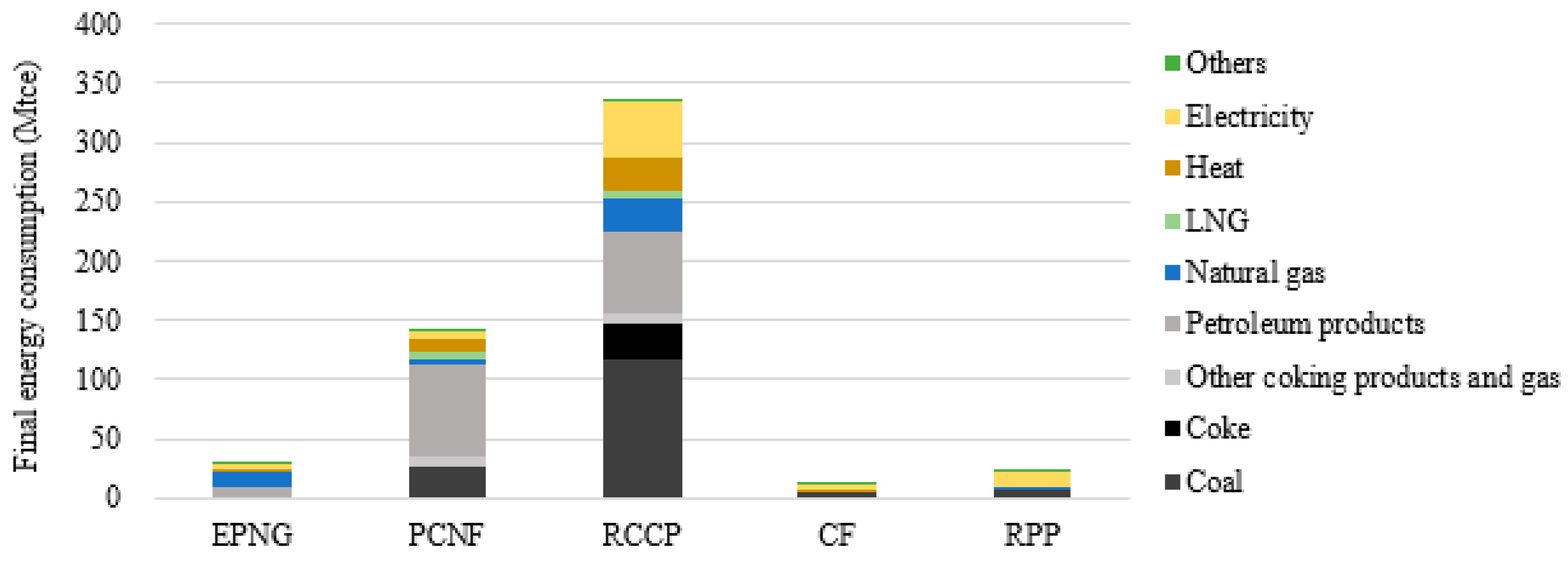
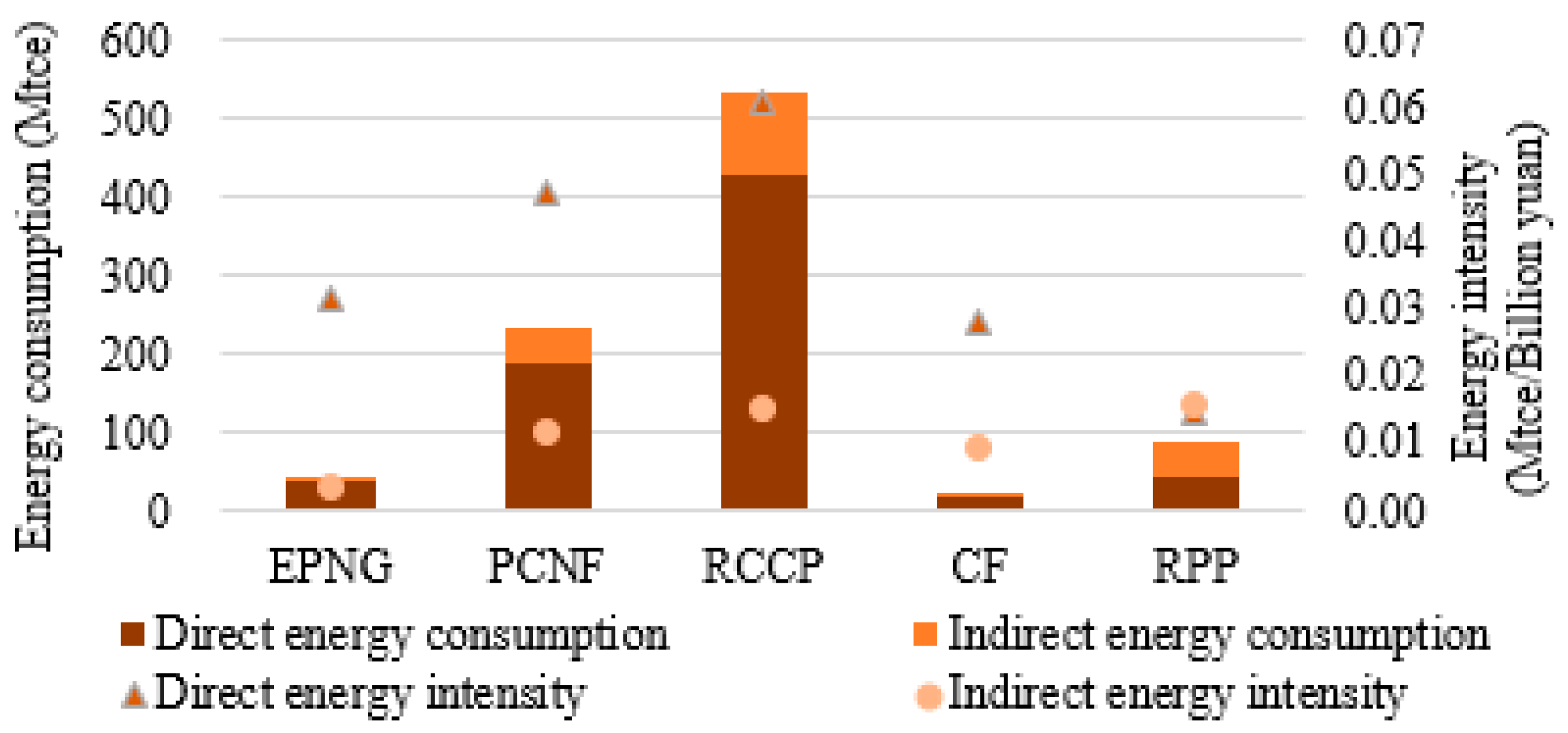
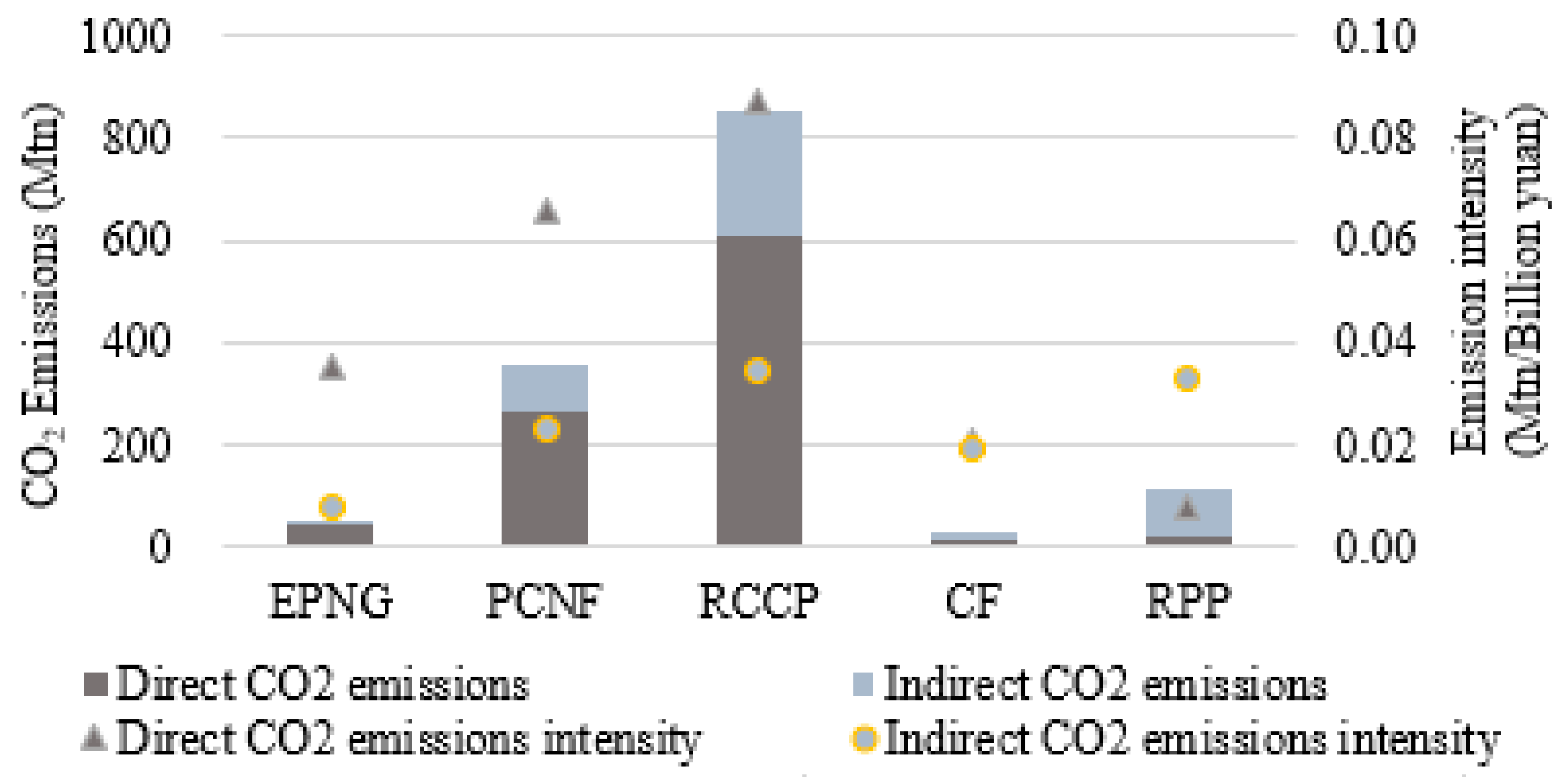
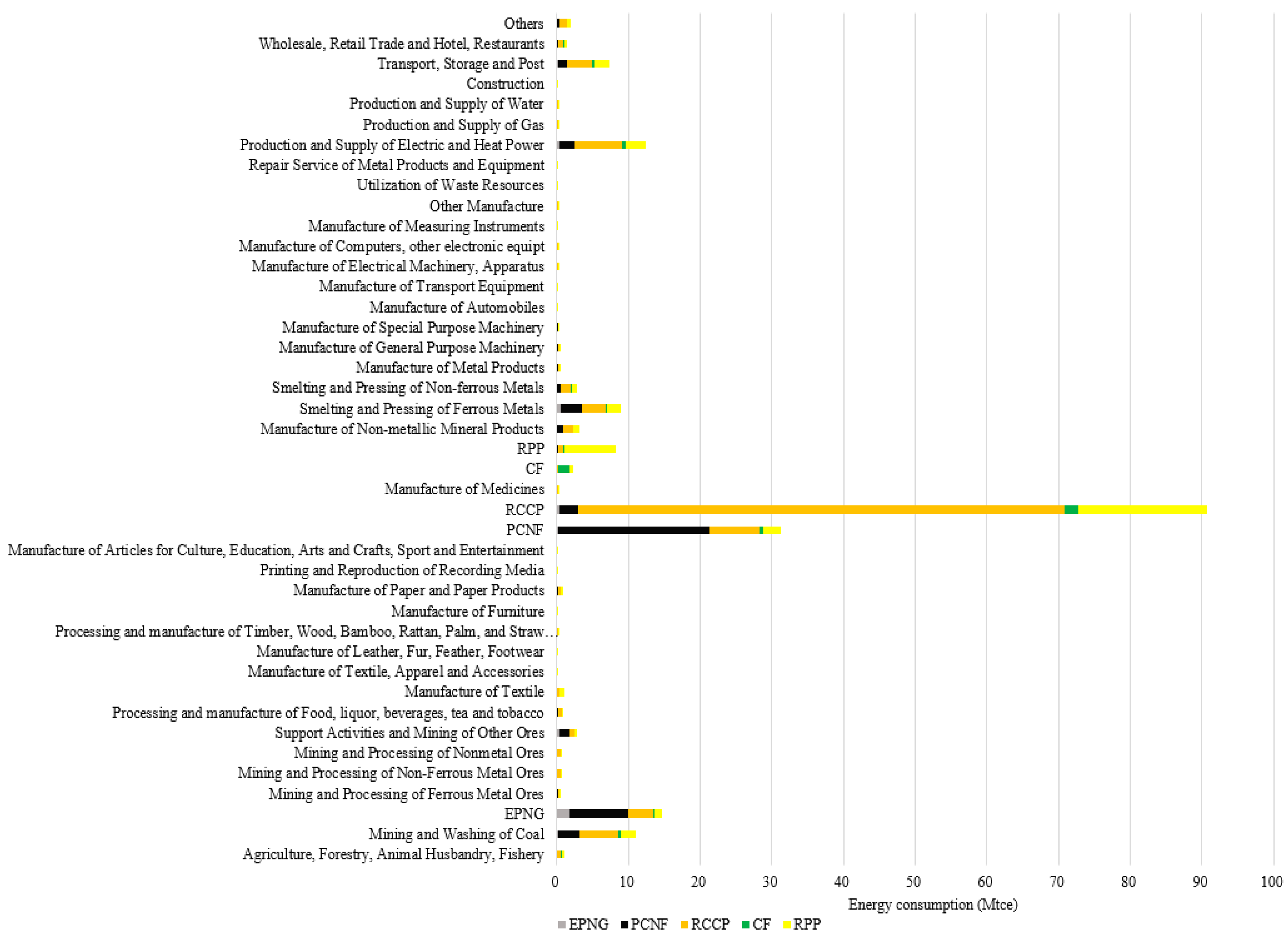
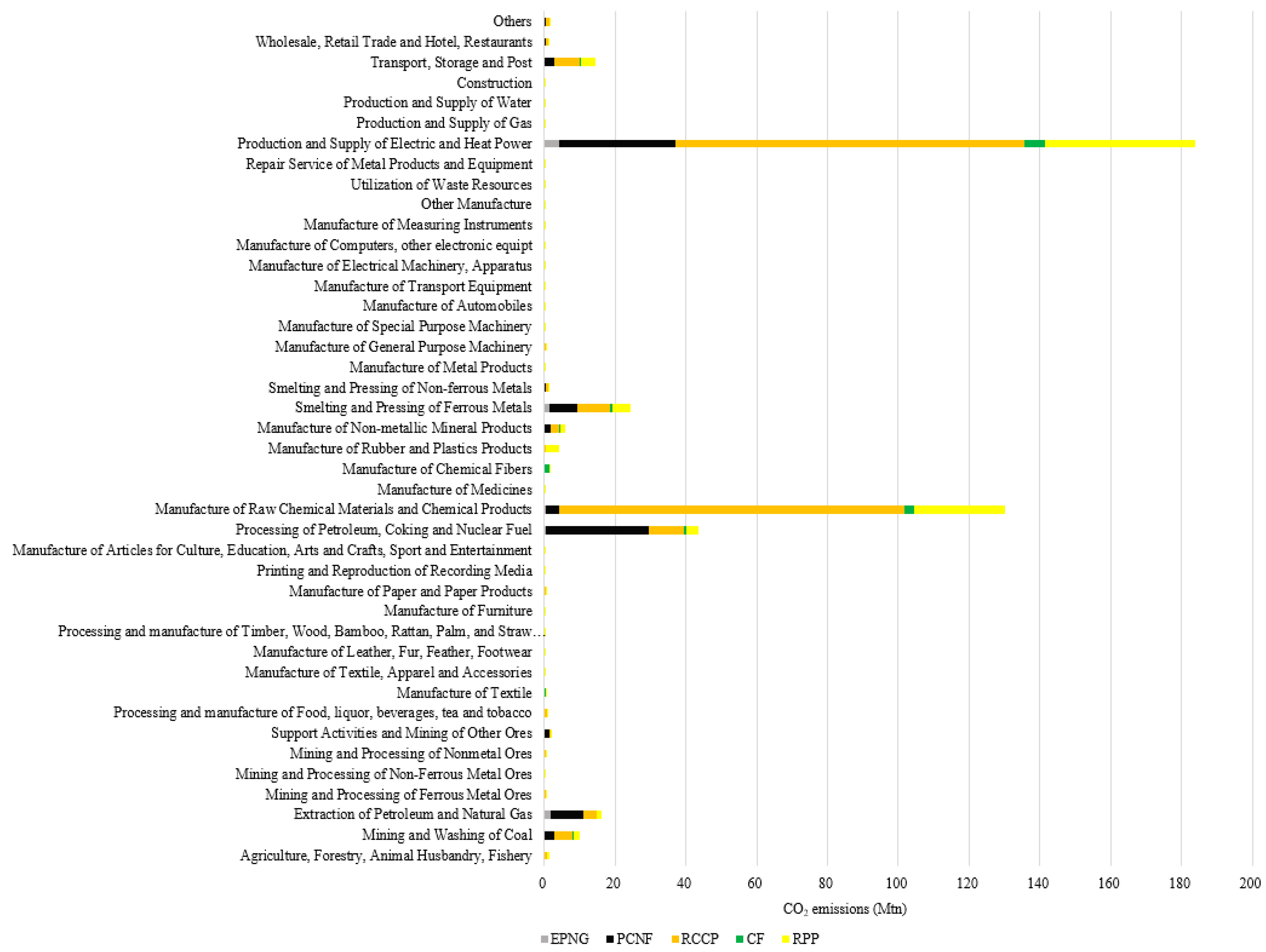
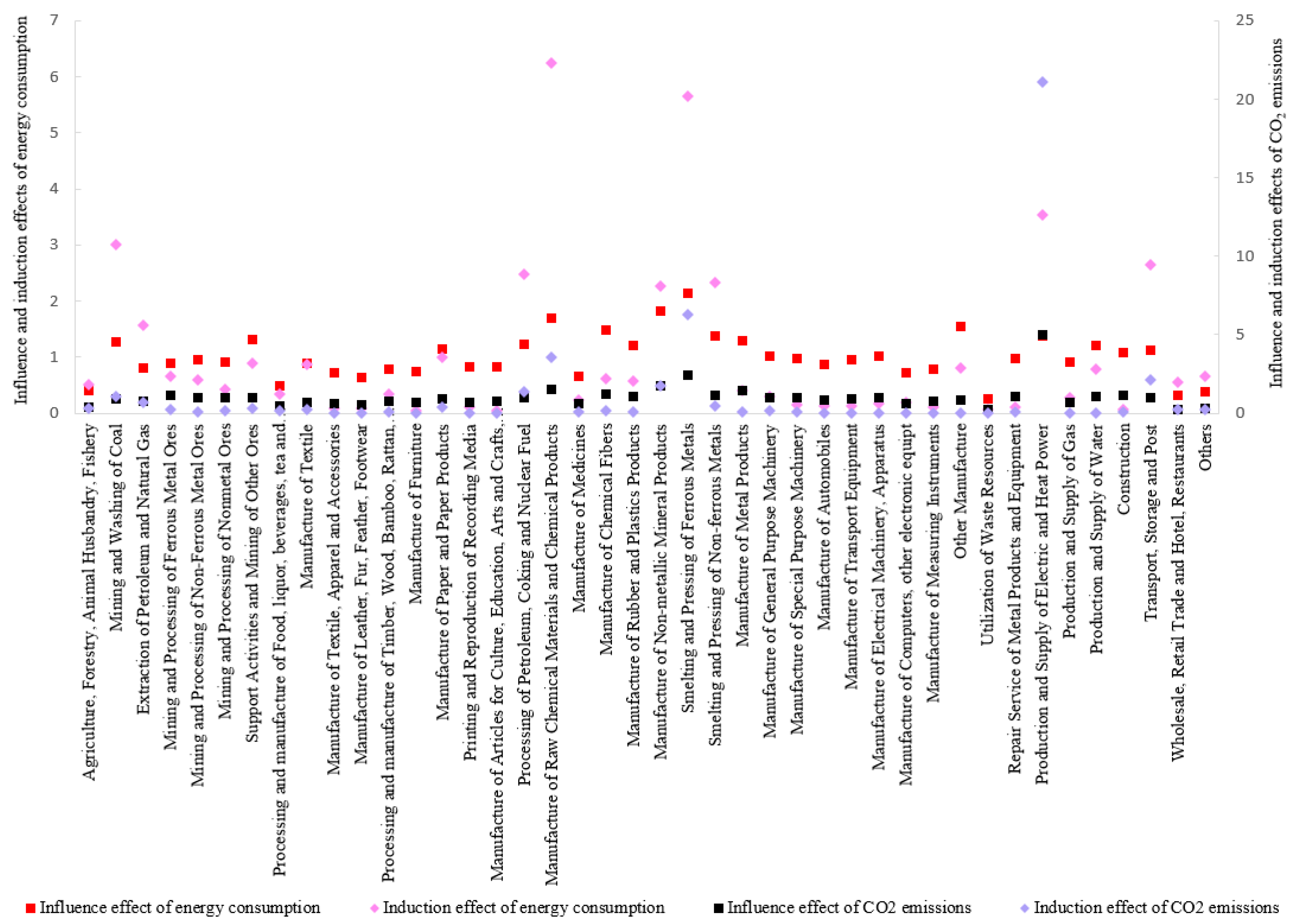
© 2017 by the authors. Licensee MDPI, Basel, Switzerland. This article is an open access article distributed under the terms and conditions of the Creative Commons Attribution (CC BY) license (http://creativecommons.org/licenses/by/4.0/).
Share and Cite
Meng, L.; Sager, J. Energy Consumption and Energy-Related CO2 Emissions from China’s Petrochemical Industry Based on an Environmental Input-Output Life Cycle Assessment. Energies 2017, 10, 1585. https://doi.org/10.3390/en10101585
Meng L, Sager J. Energy Consumption and Energy-Related CO2 Emissions from China’s Petrochemical Industry Based on an Environmental Input-Output Life Cycle Assessment. Energies. 2017; 10(10):1585. https://doi.org/10.3390/en10101585
Chicago/Turabian StyleMeng, Lu, and Jalel Sager. 2017. "Energy Consumption and Energy-Related CO2 Emissions from China’s Petrochemical Industry Based on an Environmental Input-Output Life Cycle Assessment" Energies 10, no. 10: 1585. https://doi.org/10.3390/en10101585





